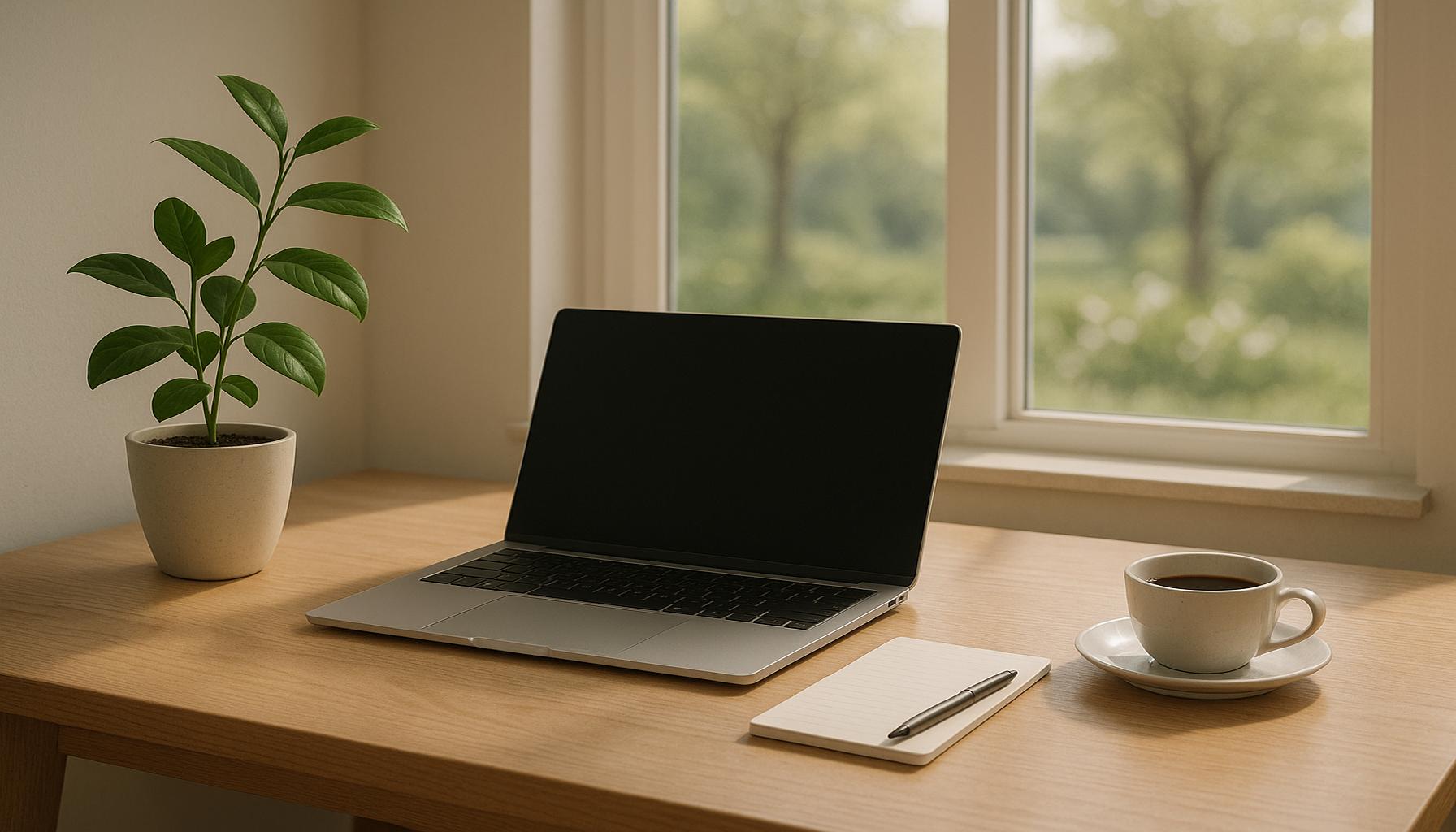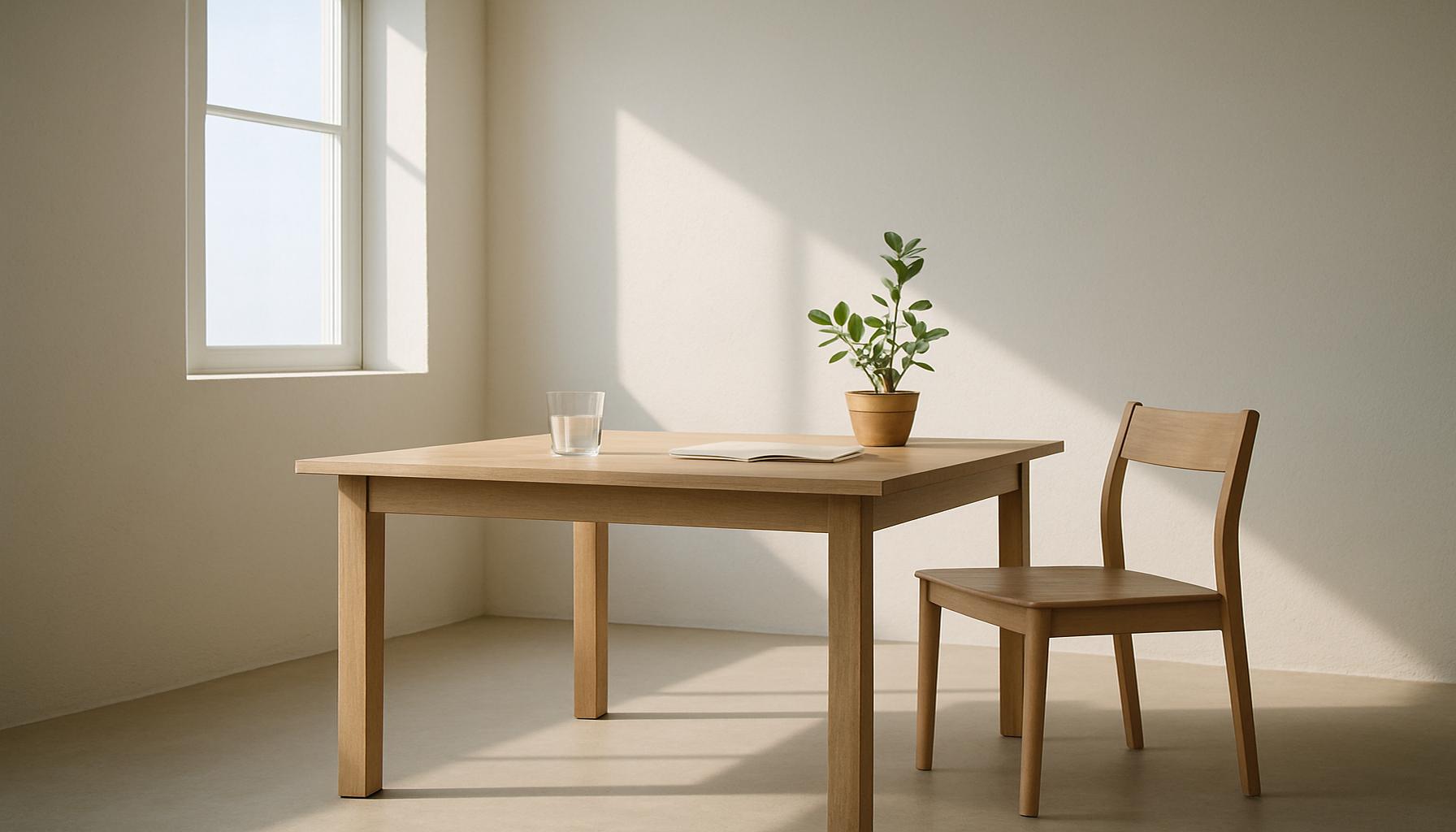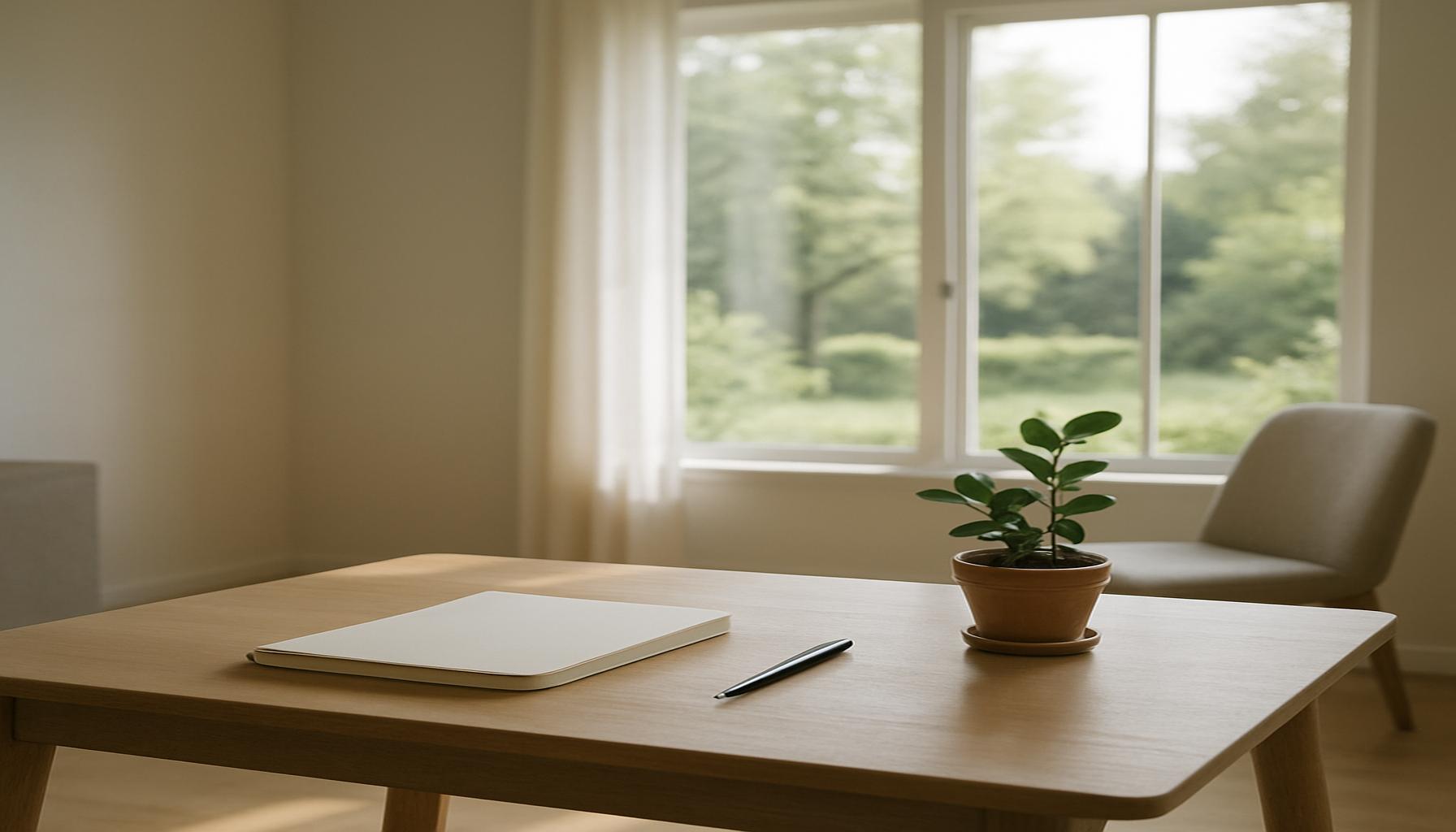Clarity in Routine: Structuring Your Day with Minimalist Principles to Reduce Stress

Finding Calm in Chaos
Life moves at an astonishing pace, and the constant rush can lead to overwhelming stress and feelings of disarray. In this whirlwind, a tidy, structured routine can create a sense of clarity and purpose, transforming the chaos of daily life into a manageable flow. Adopting minimalist principles in our routines may prove essential for achieving this balance amidst the cacophony.
Why Minimalism in Routines Matters
Incorporating minimalism into your daily structure can help you:
- Reduce mental clutter
- Enhance focus on priorities
- Lower stress levels significantly
By decluttering not just your physical environment but also your mental space, unnecessary distractions dissipate, making room for what truly matters. For example, studies show that environments with fewer items lead to decreased cognitive load, allowing individuals to focus on meaningful tasks rather than being sidetracked by excess. This notion of mental clarity is particularly relevant in today’s workspace, where interruptions from technology and multitasking can derail productivity.
Elements of a Minimalist Routine
As you embark on this transformational journey, consider these essential elements to craft a minimalist routine:
- Define your core activities: Decide which tasks contribute genuinely to your life goals. This could be dedicated time for exercise, creative pursuits, or family interactions. For instance, setting aside two hours each day for focused work can significantly increase output while preserving energy for after-hours relaxation.
- Create a consistent schedule: Much like a well-oiled machine, routines thrive on consistency. Establishing specific wake-up and sleep times empowers your body’s natural circadian rhythms. In turn, this helps boost your energy levels and keeps your stress levels in check—an especially relevant point for busy professionals juggling work and personal commitments.
- Limit decision fatigue: Plan meals and outfits ahead of time. By detailing your weekly menu and laying out clothing options the night before, you can streamline your morning routine, making space for more important decisions later in the day. Research indicates that reducing the number of decisions we make daily can improve our mental health, fostering a lighter emotional load.
By focusing on what adds value to your day, you can craft a routine that not only promotes peace but also enhances overall well-being. It encourages a lifestyle where each action is intentional, and every moment is cherished. Such an approach is not just about simplification; it’s about creating a meaningful life in a world that often feels overwhelming.
DIVE DEEPER: Click here to discover more
Building Your Ideal Framework
To effectively harness the benefits of a minimalist routine, one must first identify the core elements that not only streamline daily activities but also enhance clarity and purpose. Implementing these minimalist principles involves more than mere simplification; it requires a thoughtful approach to decision-making and habit formation. Here’s how you can reshape your day for improved mental clarity and reduced stress:
Start with Intentional Mornings
How you begin your day sets the tone for everything that follows. Consider adopting a morning ritual that encourages positivity and focus. Begin with mindful activities such as meditation, light stretching, or journaling. Research indicates that those who engage in a morning routine report higher levels of productivity and lower stress throughout the day. Taking as little as 10 to 15 minutes to center yourself can create a ripple effect that influences your entire day.
Structure Your Tasks
Creating a structured approach to your weekly tasks can greatly minimize chaos. Applying the 80/20 rule—where 20% of your efforts yield 80% of your results—helps you prioritize. Identify the essential components of your weekly schedule:
- High-Priority Tasks: What are the critical tasks that align with your short and long-term goals? List these and focus your energy on completing them first.
- Time Blocks: Allocate specific periods of uninterrupted time to work on these priority tasks. During these blocks, eliminate distractions—turn off notifications, close unnecessary browser tabs, and let others know you’re in a focused work mode.
- Regular Reviews: At the end of each week, review your accomplishments and areas for improvement. This can help refine your routine and ensure you are staying aligned with your goals while avoiding unnecessary stress.
Embrace Minimalism in Your Environment
Your physical environment plays a significant role in your mental clarity. A cluttered workspace can serve as a reminder of unfinished tasks and lead to increased feelings of stress. Here are a few strategies to create a more conducive workspace:
- Declutter: Regularly assess the items on your desk and remove anything that does not serve a purpose or contribute positively to your work.
- Organize: Invest in simple storage solutions that keep essential items within reach while maintaining an organized appearance. Use clear containers to visualize what you have rather than burying items in drawers.
- Natural Elements: Introduce plants or personal mementos to your workspace. Research highlights that interaction with natural elements can promote a sense of calm and enhance focus.
Creating a clear and intentional routine is not just about sleek organization. It’s about constructing a daily framework that elevates your overall quality of life. By focusing your energy on what truly matters, you pave the way for deeper fulfillment and reduced stress—a vital aspect in this fast-paced world.
| Advantage | Description |
|---|---|
| Increased Productivity | By eliminating unnecessary distractions, minimalist principles enable you to focus on tasks that truly matter. |
| Enhanced Mental Clarity | A structured routine reduces decision fatigue, allowing for clearer thinking and better problem-solving. |
When embracing the minimalist principles in your daily routine, it’s noteworthy that your approach to organization can dramatically enhance the efficacy of your day-to-day activities. By prioritizing tasks that align with your goals and values, you ensure that each moment spent is meaningful and productive. Additionally, the calming effect of a streamlined routine can contribute significantly to stress reduction. With less chaos and clutter in your schedule, there is a greater opportunity for reflection and creativity. Consequently, many individuals report improved mental well-being. The minimalist lifestyle encourages individuals to assess their commitments and responsibilities critically. This introspection leads to a more intentional approach to time management, allowing room for self-care and leisure, essential for maintaining balance in our increasingly busy lives. As you explore this intriguing concept, consider how implementing these practices can pave the way to a more serene existence, filled with clarity and purpose.
DIVE DEEPER: Click here to simplify your daily life
The Power of Simple Choices
To cultivate a minimalist routine, it’s essential to recognize that every decision made throughout the day contributes to your overall mental landscape. The cognitive load of choices can quickly accumulate and lead to decision fatigue. By simplifying your choices, you can enhance your clarity and reduce stress. Here are a few strategies to consider:
Limit Daily Decisions
One effective method to streamline your day is to reduce the number of decisions you make. This principle is often embraced by successful individuals—take, for instance, former President Barack Obama, who famously wore the same style of suit every day to minimize decision fatigue. Consider these practical suggestions:
- Meal Planning: Designate specific days for meal preparation. A weekly menu not only saves time and mental energy but also encourages healthier eating habits. Research shows that meal planning can significantly reduce stress associated with uncertainty around food choices.
- Wardrobe Simplification: Curate a capsule wardrobe by selecting versatile pieces that mix and match seamlessly. This not only lessens morning decision-making but also fosters a sense of intentionality in personal style.
- Automate the Routine: Explore technologies or apps that can automate repetitive tasks, such as bill payments or reminders for important tasks. This technology becomes a powerful ally in maintaining consistency and lowering daily stressors.
Mindful Breaks
Incorporating mindful breaks into your structured routine can enhance focus and resilience. Instead of plowing through tasks relentlessly, allow yourself time to recharge. Here’s how to integrate effective breaks into your day:
- The Pomodoro Technique: Work for 25 minutes and then take a 5-minute break. This interval approach can drastically improve productivity and minimize burnout while keeping your mind fresh for new tasks.
- Nature Walks: Whenever possible, step outside for a quick walk. Studies indicate that short bursts of nature exposure can reduce levels of the stress hormone cortisol and invigorate your mind.
- Breathing Exercises: Try simple breathing exercises during your breaks. Even a minute of deep, intentional breathing can bring clarity and a sense of calm to an otherwise hectic day.
Set Boundaries
Establishing boundaries surrounding your time and energy is crucial for maintaining a minimalist routine. Boundaries help you protect your mental space and prioritize what truly matters:
- Work Hours: Set strict boundaries for work hours. Communicate your schedule clearly to colleagues and family, allowing you to immerse yourself fully in work without lingering distractions or intrusions.
- Digital Detox: Allocate time slots for checking emails or social media. Limiting digital consumption can not only clear your mind but also help regain focus on essential tasks.
- Learn to Say No: Practice the art of saying no to commitments that do not align with your personal or professional goals. This helps in creating a more intentional schedule, free from unnecessary obligations that contribute to stress.
By simplifying choices, embracing mindful breaks, and setting clear boundaries, you direct your energies towards activities that amplify clarity and minimize stress. In a world where distractions abound, cultivating these minimalist principles offers a path to a more serene and productive daily experience.
LEARN MORE: Click here to discover essential strategies
Conclusion: Embracing Minimalism for Enhanced Clarity
In our fast-paced world, achieving clarity in routine is more crucial than ever. By embracing minimalist principles, individuals can simplify their daily lives, significantly reducing stress and mental fatigue. The strategies discussed—limiting daily decisions, adopting mindful breaks, and establishing clear boundaries—are not merely suggestions but transformative practices that foster intentionality and productivity.
To cultivate such a lifestyle, consider starting small—perhaps by meal planning or assessing your digital consumption. Over time, you may find that eliminating unnecessary choices leads to greater satisfaction and a clearer mind. Research consistently highlights the benefits of reducing cognitive overload, indicating that a minimalist approach can enhance both well-being and effectiveness in personal and professional realms. Furthermore, the ability to say no to non-essential tasks empowers you to create a schedule that genuinely reflects your priorities.
Ultimately, the journey towards a minimalist routine is deeply personal. It requires introspection and a commitment to fostering habits that resonate with your values. As you navigate this process, reflect on what truly enriches your day-to-day life. By finding clarity amidst chaos, you not only pave the way for a more balanced existence but also contribute to a broader cultural shift toward mindfulness and simplicity. Discovering clarity may very well lead you to a less stressful and more fulfilling daily routine.


